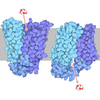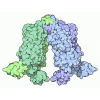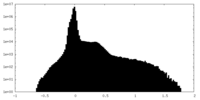+ Open data
Open data
- Basic information
Basic information
| Entry |  | |||||||||
|---|---|---|---|---|---|---|---|---|---|---|
| Title | Structure of human URAT1 bound with benzbromarone | |||||||||
 Map data Map data | sharpen map | |||||||||
 Sample Sample |
| |||||||||
 Keywords Keywords | SLC22 / urate / gout / benzbromarone / TRANSPORT PROTEIN | |||||||||
| Function / homology |  Function and homology information Function and homology informationDefective SLC22A12 causes renal hypouricemia 1 (RHUC1) / Organic anion transport by SLC22 transporters / renal urate salt excretion / urate transport / urate metabolic process / urate transmembrane transporter activity / organic anion transport / cellular homeostasis / monoatomic ion transport / PDZ domain binding ...Defective SLC22A12 causes renal hypouricemia 1 (RHUC1) / Organic anion transport by SLC22 transporters / renal urate salt excretion / urate transport / urate metabolic process / urate transmembrane transporter activity / organic anion transport / cellular homeostasis / monoatomic ion transport / PDZ domain binding / brush border membrane / cellular response to insulin stimulus / apical plasma membrane / response to xenobiotic stimulus / extracellular exosome / membrane / plasma membrane Similarity search - Function | |||||||||
| Biological species |  Homo sapiens (human) Homo sapiens (human) | |||||||||
| Method | single particle reconstruction / cryo EM / Resolution: 3.0 Å | |||||||||
 Authors Authors | Guo WJ / Wei M / Chen L | |||||||||
| Funding support |  China, 2 items China, 2 items
| |||||||||
 Citation Citation |  Journal: Nat Commun / Year: 2025 Journal: Nat Commun / Year: 2025Title: Mechanisms of urate transport and uricosuric drugs inhibition in human URAT1. Authors: Wenjun Guo / Miao Wei / Yunfeng Li / Jiaxuan Xu / Jiahe Zang / Yuezhou Chen / Lei Chen /  Abstract: High urate levels in circulation lead to the accumulation of urate crystals in joints and ultimately inflammation and gout. The reabsorption process of urate in the kidney by the urate transporter ...High urate levels in circulation lead to the accumulation of urate crystals in joints and ultimately inflammation and gout. The reabsorption process of urate in the kidney by the urate transporter URAT1 plays a pivotal role in controlling serum urate levels. Pharmacological inhibition of URAT1 by uricosuric drugs is a valid strategy for gout management. Despite the clinical significance of URAT1, its structural mechanism and dynamics remain incompletely understood. Here, we report the structures of human URAT1 (hURAT1) in complex with substrate urate or inhibitors benzbromarone and verinurad at resolution ranges from 3.0 to 3.3 Å. We observe urate in the central substrate-binding site of hURAT1 in the outward-facing conformation and urate is wrapped in the center of hURAT1 by five phenylalanines and coordinated by two positively charged residues on each side. Uricosuric compounds benzbromarone and verinurad occupy the urate-binding site of hURAT1 in the inward-facing conformation. Structural comparison between different conformations of hURAT1 reveals the rocker-switch-like mechanism for urate transport. Benzbromarone and verinurad exert their inhibitory effect by blocking not only the binding of urate but also the structural isomerization of hURAT1. | |||||||||
| History |
|
- Structure visualization
Structure visualization
| Supplemental images |
|---|
- Downloads & links
Downloads & links
-EMDB archive
| Map data |  emd_60824.map.gz emd_60824.map.gz | 59.8 MB |  EMDB map data format EMDB map data format | |
|---|---|---|---|---|
| Header (meta data) |  emd-60824-v30.xml emd-60824-v30.xml emd-60824.xml emd-60824.xml | 16.2 KB 16.2 KB | Display Display |  EMDB header EMDB header |
| FSC (resolution estimation) |  emd_60824_fsc.xml emd_60824_fsc.xml | 8.4 KB | Display |  FSC data file FSC data file |
| Images |  emd_60824.png emd_60824.png | 82.8 KB | ||
| Masks |  emd_60824_msk_1.map emd_60824_msk_1.map | 64 MB |  Mask map Mask map | |
| Filedesc metadata |  emd-60824.cif.gz emd-60824.cif.gz | 6.1 KB | ||
| Others |  emd_60824_half_map_1.map.gz emd_60824_half_map_1.map.gz emd_60824_half_map_2.map.gz emd_60824_half_map_2.map.gz | 59.3 MB 59.3 MB | ||
| Archive directory |  http://ftp.pdbj.org/pub/emdb/structures/EMD-60824 http://ftp.pdbj.org/pub/emdb/structures/EMD-60824 ftp://ftp.pdbj.org/pub/emdb/structures/EMD-60824 ftp://ftp.pdbj.org/pub/emdb/structures/EMD-60824 | HTTPS FTP |
-Validation report
| Summary document |  emd_60824_validation.pdf.gz emd_60824_validation.pdf.gz | 775.6 KB | Display |  EMDB validaton report EMDB validaton report |
|---|---|---|---|---|
| Full document |  emd_60824_full_validation.pdf.gz emd_60824_full_validation.pdf.gz | 775.2 KB | Display | |
| Data in XML |  emd_60824_validation.xml.gz emd_60824_validation.xml.gz | 16.4 KB | Display | |
| Data in CIF |  emd_60824_validation.cif.gz emd_60824_validation.cif.gz | 21.3 KB | Display | |
| Arichive directory |  https://ftp.pdbj.org/pub/emdb/validation_reports/EMD-60824 https://ftp.pdbj.org/pub/emdb/validation_reports/EMD-60824 ftp://ftp.pdbj.org/pub/emdb/validation_reports/EMD-60824 ftp://ftp.pdbj.org/pub/emdb/validation_reports/EMD-60824 | HTTPS FTP |
-Related structure data
| Related structure data |  9irxMC  9irwC  9iryC M: atomic model generated by this map C: citing same article ( |
|---|---|
| Similar structure data | Similarity search - Function & homology  F&H Search F&H Search |
- Links
Links
| EMDB pages |  EMDB (EBI/PDBe) / EMDB (EBI/PDBe) /  EMDataResource EMDataResource |
|---|---|
| Related items in Molecule of the Month |
- Map
Map
| File |  Download / File: emd_60824.map.gz / Format: CCP4 / Size: 64 MB / Type: IMAGE STORED AS FLOATING POINT NUMBER (4 BYTES) Download / File: emd_60824.map.gz / Format: CCP4 / Size: 64 MB / Type: IMAGE STORED AS FLOATING POINT NUMBER (4 BYTES) | ||||||||||||||||||||||||||||||||||||
|---|---|---|---|---|---|---|---|---|---|---|---|---|---|---|---|---|---|---|---|---|---|---|---|---|---|---|---|---|---|---|---|---|---|---|---|---|---|
| Annotation | sharpen map | ||||||||||||||||||||||||||||||||||||
| Projections & slices | Image control
Images are generated by Spider. | ||||||||||||||||||||||||||||||||||||
| Voxel size | X=Y=Z: 1.067 Å | ||||||||||||||||||||||||||||||||||||
| Density |
| ||||||||||||||||||||||||||||||||||||
| Symmetry | Space group: 1 | ||||||||||||||||||||||||||||||||||||
| Details | EMDB XML:
|
-Supplemental data
-Mask #1
| File |  emd_60824_msk_1.map emd_60824_msk_1.map | ||||||||||||
|---|---|---|---|---|---|---|---|---|---|---|---|---|---|
| Projections & Slices |
| ||||||||||||
| Density Histograms |
-Half map: half map
| File | emd_60824_half_map_1.map | ||||||||||||
|---|---|---|---|---|---|---|---|---|---|---|---|---|---|
| Annotation | half map | ||||||||||||
| Projections & Slices |
| ||||||||||||
| Density Histograms |
-Half map: half map
| File | emd_60824_half_map_2.map | ||||||||||||
|---|---|---|---|---|---|---|---|---|---|---|---|---|---|
| Annotation | half map | ||||||||||||
| Projections & Slices |
| ||||||||||||
| Density Histograms |
- Sample components
Sample components
-Entire : human urate transporter 1
| Entire | Name: human urate transporter 1 |
|---|---|
| Components |
|
-Supramolecule #1: human urate transporter 1
| Supramolecule | Name: human urate transporter 1 / type: complex / ID: 1 / Parent: 0 / Macromolecule list: #1 |
|---|---|
| Source (natural) | Organism:  Homo sapiens (human) Homo sapiens (human) |
-Macromolecule #1: Solute carrier family 22 member 12
| Macromolecule | Name: Solute carrier family 22 member 12 / type: protein_or_peptide / ID: 1 / Number of copies: 1 / Enantiomer: LEVO |
|---|---|
| Source (natural) | Organism:  Homo sapiens (human) Homo sapiens (human) |
| Molecular weight | Theoretical: 59.546602 KDa |
| Recombinant expression | Organism:  Homo sapiens (human) Homo sapiens (human) |
| Sequence | String: MAFSELLDLV GGLGRFQVLQ TMALMVSIMW LCTQSMLENF SAAVPSHRCW APLLDNSTAQ ASILGSLSPE ALLAISIPPG PNQRPHQCR RFRQPQWQLL DPNATATSWS EADTEPCVDG WVYDRSIFTS TIVAKWNLVC DSHALKPMAQ SIYLAGILVG A AVCGPASD ...String: MAFSELLDLV GGLGRFQVLQ TMALMVSIMW LCTQSMLENF SAAVPSHRCW APLLDNSTAQ ASILGSLSPE ALLAISIPPG PNQRPHQCR RFRQPQWQLL DPNATATSWS EADTEPCVDG WVYDRSIFTS TIVAKWNLVC DSHALKPMAQ SIYLAGILVG A AVCGPASD RFGRRLVLTW SYLQMAVSGT AAAFAPTFPV YCLFRFLLAF AVAGVMMNTG TLLMEWTSAR ARPLVMTLNS LG FSFGHGL TAAVAYGVRD WTLLQLAVSV PFFLCFLYSW WLAESARWLL TTGRLDRGLQ ELRRVAAING KRAVQDTLTP EVL LSAMRE ELSVGQAPAS LGTLLRTPGL RLRTCISTLC WFAFGFTFFG LALDLQALGS NIFLLQVLIG VVDIPAKMGA LLLL SRLGR RPTLAASLLL AGLCILANTL VPHEMGALRS ALAVLGLGGV GAAFTCITIY SSELFPTVLR MTAVGLGQMA ARGGA ILGP LVRLLGVHGP WLPLLVYGTV PVLSGLAALL LPETQSLPLP DTIQDVQNQA VKKATHGTLG NSVLKSTQF UniProtKB: Solute carrier family 22 member 12 |
-Macromolecule #2: [3,5-bis(bromanyl)-4-oxidanyl-phenyl]-(2-ethyl-1-benzofuran-3-yl)...
| Macromolecule | Name: [3,5-bis(bromanyl)-4-oxidanyl-phenyl]-(2-ethyl-1-benzofuran-3-yl)methanone type: ligand / ID: 2 / Number of copies: 1 / Formula: R75 |
|---|---|
| Molecular weight | Theoretical: 424.083 Da |
| Chemical component information |  ChemComp-R75: |
-Experimental details
-Structure determination
| Method | cryo EM |
|---|---|
 Processing Processing | single particle reconstruction |
| Aggregation state | particle |
- Sample preparation
Sample preparation
| Buffer | pH: 7.5 |
|---|---|
| Vitrification | Cryogen name: ETHANE |
- Electron microscopy
Electron microscopy
| Microscope | FEI TITAN KRIOS |
|---|---|
| Image recording | Film or detector model: GATAN K3 (6k x 4k) / Number real images: 3787 / Average electron dose: 70.0 e/Å2 |
| Electron beam | Acceleration voltage: 300 kV / Electron source:  FIELD EMISSION GUN FIELD EMISSION GUN |
| Electron optics | Illumination mode: FLOOD BEAM / Imaging mode: BRIGHT FIELD / Nominal defocus max: 1.8 µm / Nominal defocus min: 1.5 µm |
| Experimental equipment |  Model: Titan Krios / Image courtesy: FEI Company |
 Movie
Movie Controller
Controller









 Z (Sec.)
Z (Sec.) Y (Row.)
Y (Row.) X (Col.)
X (Col.)













































